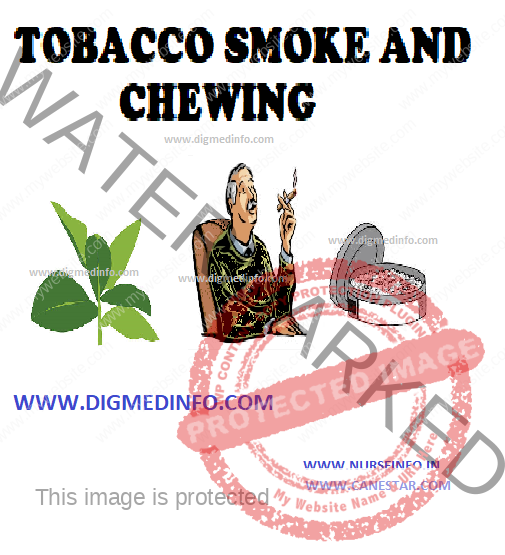TOBACCO SMOKE AND CHEWING – GENERAL CHARACTERISTICS AND TREATMENT
Man has started using tobacco from very ancient times. At present tobacco is consumed for smoking (beedi, cigarette, pipe, cigar, hookah, etc.) or for chewing with or without other constituents such as betel, arecanut, and lime or as snuff applied to the nasal or oral mucosa. All
these habits are very much prevalent in all societies in India.
GENERAL CHARACTERISTICS
Tobacco smoke contains several constituents, which irritate the respiratory tract and inhibit ciliary action. The tar that is produced is carcinogenic to the respiratory tract. Depending upon the brand of cigarette and the manner of smoking the level of carbon monoxide in the smoke may vary from 1-5%. Nicotine present in tobacco is responsible for the addiction. Sympathomimetic effects of nicotine give rise to higher heart rate, elevation of systolic and diastolic blood pressure, increase in cardiac output and peripheral vasoconstriction. The threshold for ventricular tachycardia and ventricular fibrillation is lowered. By increasing platelet aggregation, platelet adhesion, plasma fibrinogen and viscosity of blood, nicotine favors intravascular thrombosis. There is reduction in platelet survival and clotting time. Atherogenesis is favored by the rise in total cholesterol, low density lipoproteins and free fatty acids, and also fall in high density lipoproteins (HDL) brought about by nicotine. Blood levels of carboxyhemoglobin are elevated. Oxygen carrying capacity of blood is reduced. Rise in blood carbon monoxide leads to intimal hypoxia, increase in the permeability of arterial intima and lipid deposition.
Cigarette smoking is associated with mild airway obstruction and impairment of lung function in adolescents. Females are affected more. Heavy smokers suffer from tachycardia, palpitation, cardiac arrhythmias, hypertension, tremors, anorexia, agitation and insomnia. In those who practice the chewing habit, in addition to absorption of nicotine from the buccal mucosa the local irritation caused by the cud leads to precancerous and cancerous changes.
SMOKING
Tobacco is a highly habit forming agent. Several studies have been shown that the first cigarette exposes the individual and the addiction will occur even with the second or third ‘smoke’. Children of smoking parents acquire this habit more freely. The harmful ingredients taken up by the smoker and exhaled by him depend upon several factors such as the number of cigarettes smoked and their frequency, depth of inhalation, smoking the cigarette only partially or fully and the environment in which the smoker smokes – whether open or confined space. Inhalation of the exhaled smoke by others nearby is termed passive smoking, which is also associated with adverse effects in various degrees.
There is irrefutable evidence that smoking is a major risk factor for chronic bronchitis, emphysema and cancers of lung, larynx, esophagus, bladder, kidney, pancreas and cervix uteri. Coronary heart disease, hypertension, strokes, peripheral vascular occlusions, thromboangitis obliterans, peptic ulcers and several other conditions are directly or indirectly attributable to tobacco. Tobacco is the most important cause of cancer and cancer death, affecting several organ systems. Both main stream and second hand smoke are group-1 carcinogens, i.e. included among the highest cancer causing agents in humans. Lung cancer is several times more common in smokers compared to nonsmokers. 90% of bronchogenic carcinoma is related to smoking, either direct or passive. Smoking contributes to 50% of the death of cigarette smokers, with half of these deaths occurring in middle life. Smokers lose 10 years of their life expectancy, compared to non-smokers.
Smoking by parents has an adverse effect on their children. Smoking mothers have an increased risk of spontaneous abortion and their children have lower birth weights, higher perinatal mortality and a greater risk of sudden infant death syndrome. Medical associations of several countries have urged their governments to undertake measures to restrict the spread of tobacco habit. These include restriction of sales of tobacco to those below the age of 18 years, ban on advertisement, education in schools and through public media, prohibition of smoking in public places and public transport, heavy taxation on cigarettes and withdrawal of aids to tobacco industry.
Tobacco Chewing
There are recent reports from India that chewing tobacco is also associated with increased risk of cardiovascular morbidity. Further studies are needed. Betel chewing as a cause of oral cancer is well known. Several brands of such proprietary preparations (Pan Masalas) are available in the Indian market. These are being used by a large number of persons, especially the youth. Their role in the genesis of oral cancer and other systemic diseases is not yet fully assessed.
OCCUPATIONAL HEALTH PROBLEMS AMONG TOBACCO WORKERS
The varieties of tobacco include Virginia tobacco (cigarette tobacco) and non-virginia tobacco. Persons may be exposed to tobacco during agricultural operations or curing processes. Ill effects of tobacco are considered to be due to absorption of nicotine through the skin or respiratory tract. The levels of nicotine and its metabolic product cotinine are increased in urine.
The symptom complex occurring in the exposed workers is collectively known as green symptoms. These consist of neurological symptoms like headache, giddiness, nausea, vomiting, prostration and respiratory symptoms such as cough and dyspnea. Usually, these symptoms are transient. The occurrence of green symptoms is associated with raised urinary levels of nicotine and cotinine. Virginia tobacco is less toxic than the non-virginia variety. The respiratory symptoms may be aggravated by aero-allergens such as pollen and fungi belonging to the species Gladosporium and Altemaria. The nature of contact with tobacco also partly determines the clinical manifestations. Persons who pluck the leaves generally get headache and giddiness, while those carrying the leaves for curing get nausea and vomiting. In agricultural workers engaged in curing, entry of tobacco is through the respiratory tract.
Treatment
Since the symptoms are usually mild, and last only for a few hours, removal from the surroundings is itself curative. The local practice among the workers is to take tea and jaggery followed by rest.


